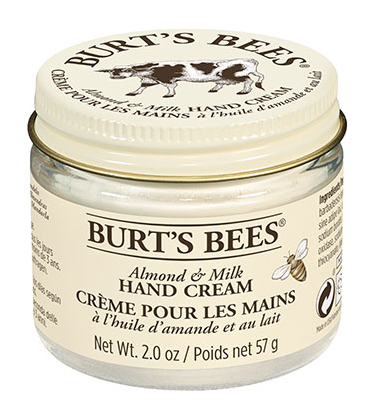The long an often arduous Canadian winters make moisturizers for every part of one’s skin an essential part of one’s personal hygiene regimen. I’m sure a couple of tons of the stuff is slathered on every winter in a desperate attempt to avoid the discomfort of tightening dry skin.
Which makes it all the more important to find a good moisturizer both with regards to the effect it has as well as the effect of its production and use on the environment.
The latest in the line of hand moisturizers I’ve used is Burt’s Bees Almond Milk Beeswax Hand Cream. I’ve felt very confident in using this and other Burt’s Bees products, as the company, from what I could tell, was bent on minimizing its negative impact on the environment as well as committed to providing customers with healthy products.
Why Burt’s Bees?
 I’m always trying to figure out how to align my material needs with my moral and spiritual beliefs. One of the reasons I chose to invest in Burt’s Bees products is the company’s self-describes mandate to create products that are earth-friendly. To do so, the company makes products with natural ingredients and try to use minimal processing to maintain the ingredients’ purity. I particularly appreciate the scale of “naturality” (my word, not theirs) that gives a product’s percentage of natural ingredients, a tool which allows customers to make a more informed decision about what they apply to their skin. The company also has quite a bit going on with regards to sustainability and the environment.
I’m always trying to figure out how to align my material needs with my moral and spiritual beliefs. One of the reasons I chose to invest in Burt’s Bees products is the company’s self-describes mandate to create products that are earth-friendly. To do so, the company makes products with natural ingredients and try to use minimal processing to maintain the ingredients’ purity. I particularly appreciate the scale of “naturality” (my word, not theirs) that gives a product’s percentage of natural ingredients, a tool which allows customers to make a more informed decision about what they apply to their skin. The company also has quite a bit going on with regards to sustainability and the environment.
However, Burt’s Bees is now owned by The Clorox Company, which has had to deal with a few dealings that raised some eyebrows. For one, the company has been questioned as to its limited and mostly financially motivated foray into “green” cleaning products. For another, the company has apparently made false claims as to the effectiveness of these same products. The Clorox Company has also been named one of a dangerous dozen chemical companies by the Public Interest Research Group, albeit in 2004. Other issues are mentioned here, here, and here.
All of this makes the case for finding a hand cream from a company that does not belong to The Clorox Company.
How did it fare this winter?
 The cream is very greasy but absorbs quickly and efficiently into the skin; what worked for me was applying a little bit a couple of times a day instead of a big glob only once or twice a day. I also noticed that it helped strengthen my nails. Although they usually crack so much by the end of winter that I tend to keep them short, I was able to keep them long throughout the winter season.
The cream is very greasy but absorbs quickly and efficiently into the skin; what worked for me was applying a little bit a couple of times a day instead of a big glob only once or twice a day. I also noticed that it helped strengthen my nails. Although they usually crack so much by the end of winter that I tend to keep them short, I was able to keep them long throughout the winter season.
The format—a 5 cm x 5cm cylindrical glass jar with a thin metallic cap—lends itself well to being left on one’s desk. It was very easy to adopt a routine by which I would put a bit of a cream on a couple of times a day and massage it in while reading something on the screen.
The materials of the jar make it recyclable—another plus—but I kept mine to use as a paper clip holder, decorated of course with a little bit with washi tape.
Final Verdict
While Burt’s Bees is a company whose policies and approach I like, and while this hand cream did perform admirably well, once my current stash is empty, I will start looking for an alternative that is less ethically murky. It’s quite unfortunate, as I really love their lip balms as well—but continuing to support, even indirectly, a corporation I can’t fully trust and has a huge potential to negatively harm, doesn’t feel coherent with my desire to contribute to the betterment of the world.


I love Burt’s Bees products, but I’ve also stopped using them due to their connection to Clorox. When small brands with progressive corporate policies are bought up by large companies, good things rarely result.
It’s found it tough to be honest! I love their products as well. I wonder how many of my favorite brands I’m going to have to let go of as I review them one by one… Egad!